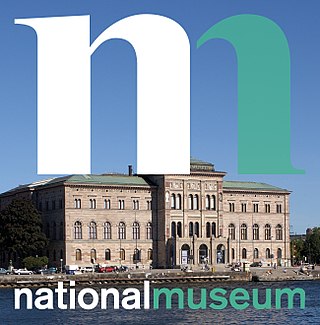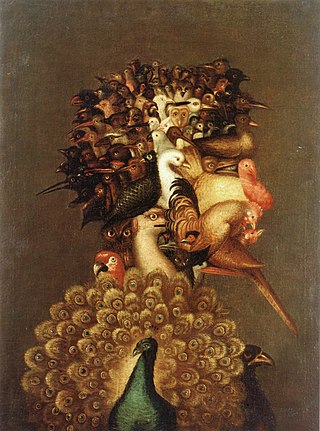
Mannerism, which may also be known as Late Renaissance, is a style in European art that emerged in the later years of the Italian High Renaissance around 1520, spreading by about 1530 and lasting until about the end of the 16th century in Italy, when the Baroque style largely replaced it. Northern Mannerism continued into the early 17th century.

Rudolf II was Holy Roman Emperor (1576–1612), King of Hungary and Croatia, King of Bohemia (1575–1608/1611) and Archduke of Austria (1576–1608). He was a member of the House of Habsburg.

The Kunsthistorisches Museum is an art museum in Vienna, Austria. Housed in its festive palatial building on the Vienna Ring Road, it is crowned with an octagonal dome. The term Kunsthistorisches Museum applies to both the institution and the main building. It is the largest art museum in the country and one of the most important museums worldwide.

Ferdinand II, Archduke of Further Austria was ruler of Further Austria and since 1564 Imperial count of Tirol. The son of Ferdinand I, Holy Roman Emperor, he was married to Philippine Welser in his first marriage. In his second marriage to Anna Juliana Gonzaga, he was the father of Anna of Tyrol, future Holy Roman Empress.

Nationalmuseum is the national gallery of Sweden, located on the peninsula Blasieholmen in central Stockholm.

Skokloster Castle is a Swedish Baroque castle built between 1654 and 1676 by Carl Gustaf Wrangel, located on a peninsula of Lake Mälaren between Stockholm and Uppsala. It became a state museum in the 1970s and displays collections of paintings, furniture, textiles and tableware as well as books and weapons that amount to 20,000 items.

The Jurist, also known as The Lawyer, is an oil-on-canvas painting by Italian artist Giuseppe Arcimboldo, painted in 1566.

Ambras Castle is a Renaissance castle and palace located in the hills above Innsbruck, Austria. Ambras Castle is 632 metres (2,073 ft) above sea level. Considered one of the most popular tourist attractions of the Tyrol, Ambras Castle was built in the 16th century on the spot of an earlier 10th-century castle, which became the seat of power for the Counts of Andechs. The cultural and historical importance of the castle is closely connected with Archduke Ferdinand II (1529–1595) and served as his family's residence from 1567 to 1595. Ferdinand was one of history's most prominent collectors of art. The princely sovereign of Tyrol, son of Emperor Ferdinand I, ordered that the medieval fortress at Ambras be turned into a Renaissance castle as a gift for his wife Philippine Welser. The cultured humanist from the House of Habsburg accommodated his world-famous collections in a museum: the collections, still in the Lower Castle built specifically for that museum's purpose, make Castle Ambras Innsbruck one of the oldest museums in the world.

Wolfgang Laz, better known by his Latinized name Wolfgang Lazius, was an Austrian humanist who worked as a cartographer, historian, and physician.

People often see hidden faces in things. Depending on the circumstances, this is referred to as pareidolia, the perception or recognition of a specific pattern or form in something essentially different. It is thus also a kind of optical illusion. When an artist notices that two different things have a similar appearance, and draws or paints a picture making this similarity evident, they make images with double meanings. Many of these images are hidden faces or hidden skulls.

Northern Mannerism is the form of Mannerism found in the visual arts north of the Alps in the 16th and early 17th centuries. Styles largely derived from Italian Mannerism were found in the Netherlands and elsewhere from around the mid-century, especially Mannerist ornament in architecture; this article concentrates on those times and places where Northern Mannerism generated its most original and distinctive work.

The Chamber of Art and Wonders is a cabinet of curiosities created in the 16th century by Ferdinand II, Archduke of Austria and located in Innsbruck, Austria. Ferdinand II was the sovereign ruler of the County of Tyrol and Further Austria, and a prominent collector of art. He built this museum specifically to showcase his collections.

The Lobkowicz Palace is a part of the Prague Castle complex in Prague, Czech Republic. It is the only privately owned building in the Prague Castle complex and houses the Lobkowicz Collections and Museum.

Giuseppe Arcimboldo was an Italian painter best known for creating imaginative portrait heads made entirely of objects such as fruits, vegetables, flowers, fish and books.

The Four Elements is a series of four oil paintings by the Italian artist Giuseppe Arcimboldo which were created in 1566, during the Renaissance, for Maximilian II, Holy Roman Emperor. The paintings depict human faces in profile made up from different animals or objects. Air is represented by birds, Fire by burning wood and cannons, Earth by land animals and Water by marine creatures. The series attempts to express the creation of harmony from chaos by the careful arrangement of the wild animals to form portraits whilst also praising Maximilian by suggesting that he is a ruler who controls even the four primal elements.

Vertumnus is an oil painting produced by the Italian painter Giuseppe Arcimboldo in 1591 that consists of multiple fruits, vegetables and flowers that come together to create a portrait of Holy Roman Emperor Rudolf II. Although Arcimboldo's colleagues commented that Vertumnus was scherzo, or humorous, there were intentional political meanings behind the piece, particularly regarding the choice of fruits, vegetables, and flowers. Arcimboldo's choice to include these items was also an intentional reference to the Roman god, Vertumnus.
František Makeš is a Swedish artist, scientist and chemist, speciaslising in the conservation of art objects.
Proto-Surrealism is a term used for Surrealism avant-la-lettre. It is the study of various forms of art, literature, and other mediums that correspond to, reference, or share similarities to the 20th-century art movement known as Surrealism. This definition is considered a controversial topic, with many debating the suitability of the term surrealism to describe these bodies of work and instead opting to use the term Fantastique or Fantastic Art.

The Prague Altarpiece of Lucas Cranach the Elder portrays the Virgin Mary and female saints was, at the time it was made, the second most important altarpiece in St Vitus Cathedral. The altarpiece was most probably brought to Prague as a commission by Emperor Maximilian I. The reason for this could have been the betrothal of his granddaughter Mary to Louis II of Hungary, the engagement of Ferdinand I and Anna Jagiellon (1515) or the coronation of Mary of Habsburg as Queen of Bohemia (1522). A hundred years later, in 1619, the altarpiece fell victim to Calvinist iconoclasm. The figures of the female saints were cut out of it and its central part was destroyed.

Fanny Elisabeth Wilhelmina Hjelm was a Swedish visual artist.


















